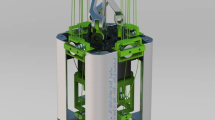Abstract
The F/T sensor investigated in this study utilizes the Stewart Platform Mechanism Structure. Normally-employed 6-prismatic joints are replaced by 6-prismatic bars, which are extensible and compressible only along the axial direction of the bars. The complete analyses for the design of this kind of F/T sensor are conducted: the position analysis, the first-order and second-order kinematic analyses, and the force-deformation analysis based on the first-order kinematic characteristics of the system. Lastly, a dimensional synthesis for the F/T sensor is performed based on the kinematic isotropic index.
Similar content being viewed by others
References
Freeman, R. A. and Tesar, D., 1988, “Dynamic Modeling of Serial and Parallel Mechanisms/Robotic Systems, Part I: Methodology, Part II: Applications,”Trends and Developments in Mechanisms, Machines, and Robotics, 20th Biennial Mechanism Conf., Kissimmee, FL, DE Vol. 15-2, pp. 7–21.
Kak, A. C. and Albus, J. S., 1985, “Sensors for Intelligent Robots,” Chap. 13. inHandbook of Industrial Robotics, edited by Shimon Y. Nof, published by John Wiley & Sons.
Kim, W. K., Huh, K. K., Huh, H., 1993, “Analysis of Wrist-Type 6-Degree-of-Freedom Force/Torque Sensors Based on Stewart Platform Structure,”Journal of Korea-University Science and Technology Institute, Vol. 1, pp. 57–74.
Kim, W. K., 1994, Huh, K. K., Yi, B. J. and Cho, W., “Optimal Design of Wrist-Type 6-Degree-of-Freedom Force/Torque Sensors Based on Stewart Platform Structure,”Proceedings of KSME Spring Conference, pp. 668–673.
Kozo Ono and Yotaro Hatamura, 1986, “A New design For 6-Component Force/Torque Sensors,”Proceedings of the XIth International Conference on Measurement of Froce and Mass, Amsterdam, The Netherlands, pp. 39–48.
Ma, O. and Angeles, J., 1992, “Architecture Singularities of of Parallel Manipulators,”Int'l Journal of Robotics and Automation, Vol. 7, No. 1, pp. 23–29.
Nakamura, Y., Yoshikawa, T. and Futamata, I., “Design and Signal Processing of Six-Axis Force Sensors.”
Nguyen, C. C., Antrazi, S. S., Zhou, Z. L. and Campbell, Jr, C.E., 1992, “Analysis and Experimentation of Stewart Platform-Based Force/Torque Sensor,”Int'l Journal of Robotics and Automation, Vol. 7, No. 3, pp. 133–140.
Reboulet, C. and Pigeyre, R., 1992, “Hybrid Control of a 6-DOF In-Parallel Actuated Micro-Manipulator Mounted on a SCARA Robot,”IEEE Int'l Journal of Robotics and Automation, Vol. 7, No. 1, pp. 10–14.
Shimano, B. and Roth, B., 1978, “On Force Sensing Information and Its Use in Controlling Manipulator,”Proc. of the 8th Industrial Symposium on Industrial Robots, Washington, D.C. pp. 119–126.
Svinin, M. M. and Uchiyama, M., 1994, “Analytical Models for Designing Force Sensors,”Proceeding of IEEE Conference, Robotics and Automation, pp. 1778–1783.
Uchiyama, M., Nakamura, Y. and Hakomori, K., 1991, “Evaluation of the Robot Force Sensor Structure Using Singular Value Decomposition,” Advanced Robotics, Vol. 5, No. 1, pp. 39–52.
Yabuki, A., 1990, “Six-Axis Force/Torque Sensor for Assembly Robots,”Fujitsu Sci. Tech. J., Vol. 26, No. 1, pp. 41–47.
Yoshida, T., 1984, “6-Component Force Transducer and Its Application,”Proceedings of the 10th conference of IMERO TC3 on Measurement of Force and Mass, Japan, Sep., pp. 11–15.
Yoshikawa, T. and Miyazaki, T., 1989, “A Six-Axis Force Sensor with Three-Dimensional Cross-Shape Structure,”IEEE int'l conf. on Robotics and Automation, pp. 249–255.
Author information
Authors and Affiliations
Rights and permissions
About this article
Cite this article
Kim, WK., Huh, KK., Yi, BJ. et al. Optimal synthesis of a wrist-type 6 degree-of-freedom force/ torque sensor using Stewart Platform Structure. KSME Journal 9, 462–471 (1995). https://doi.org/10.1007/BF02953644
Received:
Issue Date:
DOI: https://doi.org/10.1007/BF02953644




